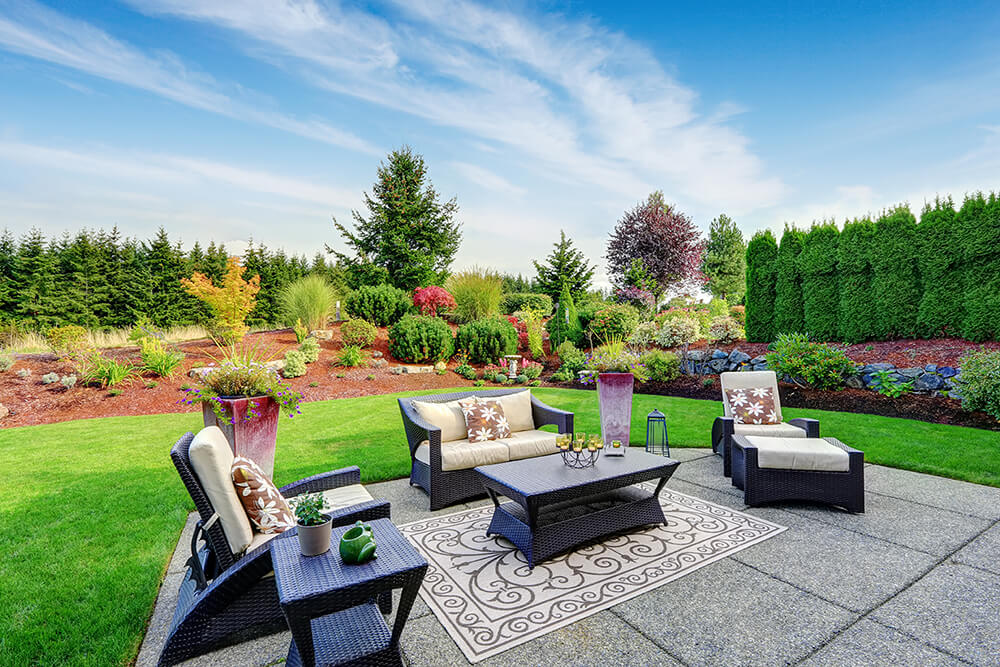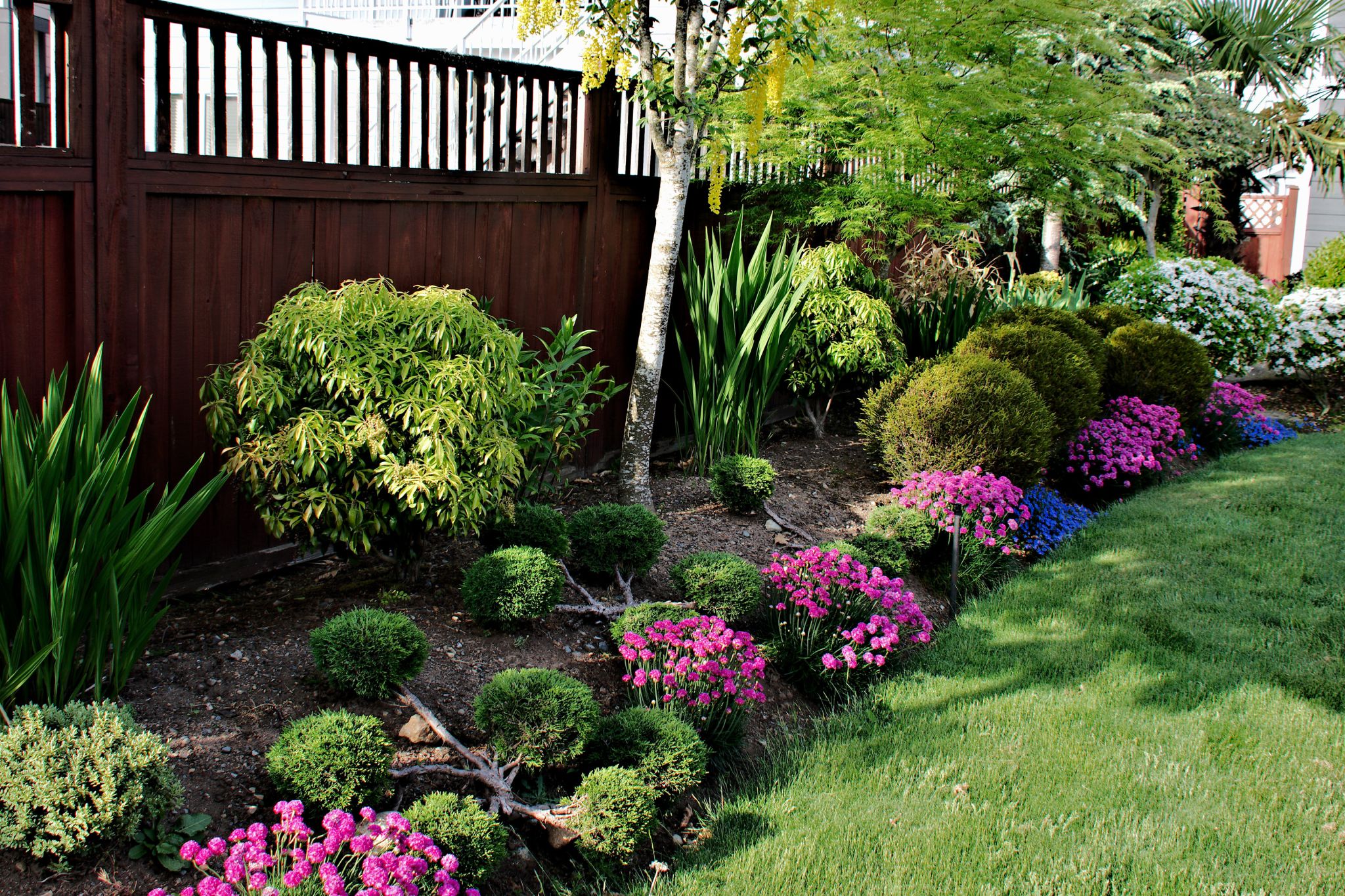Transform Your Room With Specialist Outdoor Landscaping Solutions: From Patios to Outdoor Kitchens
Transforming exterior rooms calls for expertise and mindful planning. Specialist landscaping services can boost a residential property's functionality and appearances. From designing inviting patios to crafting completely furnished outdoor kitchen areas, these experts bring important expertise. They contemplate local environments and sustainable practices, guaranteeing each task straightens with the property owner's vision. What are the crucial elements to contemplate when initiating such a makeover? The answers could surprise you.
The Advantages of Professional Outdoor Landscaping
:strip_icc()/beautiful-backyard-9m5TLyolK7O8wOthw2zojq-b94978095212441dbe110278d977db2e.jpg)
Creating Your Suitable Patio Area
When planning the excellent patio, home owners ought to assess both functionality and aesthetic appeals to create an area that enhances their way of life. A well-designed outdoor patio offers as an expansion of the home, giving a suitable location for leisure, home entertainment, or dining outdoors. Key factors to consider consist of the dimension and form of the patio area, which must balance with the surrounding landscape and home architecture.Material selection is likewise important; options such as natural rock, pavers, or wood can boost the overall look while using sturdiness. Home owners must consider furniture setup, guaranteeing adequate room for motion and comfort. Integrating elements like shade frameworks, fire pits, or planters can include personality and utility.Lighting plays a considerable function in patio style, improving setting and usability throughout evenings. Eventually, a thoughtfully created outdoor patio can elevate exterior living experiences and boost building worth.
Creating an Outdoor Kitchen Area
Developing an exterior kitchen area boosts the performance and satisfaction of any kind of outdoor room. Trick attributes, such as grills, counter tops, and storage space, play a vital function in the layout and format of this cooking place. By taking into consideration crucial elements, homeowners can craft a space that effortlessly mixes with their landscape while satisfying their cooking needs.
Necessary Kitchen Functions
An outside kitchen area can transform a yard into a culinary sanctuary, improving both capability and social interaction. Crucial cooking area functions include a robust grill, which functions as the centerpiece for exterior food preparation, enabling various cooking designs. Counter room is essential, giving adequate space for food prep work and serving. A sink is likewise crucial, making it possible for very easy cleanup and helping with cooking tasks. Additionally, integrating a fridge assurances active ingredients and drinks remain fresh and easily accessible. Storage solutions, such as closets or racks, help maintain organization and performance. Including weather-resistant products guarantees longevity and toughness, making the outside kitchen area a reputable room year-round. Together, these functions create a welcoming environment for household events and enjoyable guests.
Layout and Format Tips
While creating an outdoor cooking area, cautious idea of the format can substantially boost both capability and visual appeals. Outdoor kitchens. A reliable format starts with zoning, dividing the room into food preparation, eating, and prep work locations. Putting the grill near the food prep zone improves the cooking procedure, while guaranteeing sufficient counter room for meal setting up is necessary. Integrating an eating area that permits for easy activity encourages social interaction. In addition, integrating storage space solutions such as cabinets and cabinets maintains the space organized. It is essential to review the circulation of foot website traffic, avoiding congestion by maintaining clear pathways. Lastly, making use of durable products that stand up to outside problems guarantees durability, while thoughtful lights can produce an inviting setting for evening gatherings

Enhancing Aesthetic Charm With Landscape Design
Enhancing visual charm through landscaping involves a mindful equilibrium of style components that draw attention and produce a welcoming ambience. Strategic plant placement can highlight building attributes, while thoughtful hardscaping adds framework and impact. Together, these elements transform the exterior of a property, making a lasting impression on site visitors and passersby.
Design Components That Astound
Involving layout elements play an important role in boosting a property's curb charm, as they develop an inviting initial perception for visitors and passersby alike. Attentively designed functions, such as ornamental paths, classy fence, and vivid flower beds, contribute to a cohesive aesthetic. Special focal factors, like an elegant water attribute or a striking sculpture, can attract focus and trigger passion. In addition, well-placed outdoor illumination not only lights up paths but also highlights building information throughout the night. Integrating multi-level landscapes with varying appearances and colors adds deepness and dimension, developing a vibrant aesthetic experience. Eventually, these charming style components function harmoniously to raise the overall charm of a residential property, making it attract attention in your area.
Strategic Plant Placement
Strategic plant placement considerably influences a property's aesthetic charm, enhancing the interesting layout components already in position. By thoughtfully picking and placing plants, property owners can produce a harmonious blend of color, structure, and height that draws the eye. Positioning taller plants towards the back and shorter ones in front establishes deepness. Furthermore, utilizing indigenous plants can improve the landscape's sustainability while offering seasonal rate of interest. Vivid flowers can be intentionally positioned near paths or entrances to invite guests, while evergreen bushes offer year-round framework. Integrating seasonal blossoms warranties continuous visual charm. Overall, tactical plant plans not just elevate appearances however also add to an inviting atmosphere that shows the house owner's style and boosts the overall residential or commercial property value.
Hardscaping for Effect
While plants play a necessary role in landscaping, hardscaping aspects can considerably boost a property's curb appeal by supplying framework and aesthetic rate of interest. Features such as rock pathways, block patio areas, and attractive walls produce a solid structure that enhances greenery. These aspects not just specify rooms however likewise overview site visitors via the landscape, boosting the general experience. Additionally, integrating outdoor illumination into hardscaping can emphasize building information and produce a cozy, inviting ambience during the evening. Fire pits and outside kitchen areas include capability, making outside areas more habitable and enticing. By mixing hardscaping with soft landscaping, home owners can achieve an unified balance that astounds the eye and boosts building worth. Ultimately, thoughtful hardscaping transforms outside areas into sensational displays.
Picking the Right Plant Kingdoms and Materials
When selecting plants and products for exterior landscaping, it is necessary to ponder aspects such as climate, soil problems, and meant use the space. An effective landscape design balances with the native environment, making sure that picked plants read more thrive and add to the general visual. Local climate influences the choice of flora; for example, drought-resistant varieties are more suitable in dry regions, while rich plant fits much more pleasant climates.Soil quality likewise plays a substantial role in plant health and wellness. Performing dirt tests can help determine pH levels and vitamins and mineral material, leading the option of suitable plant varieties. In addition, the designated usage of the space-- be it for leisure, entertaining, or gardening-- will affect selections regarding plants and materials. Resilient, weather-resistant products are important for hardscaping components like patio areas and sidewalks, while selecting plants that provide year-round passion enhances the landscape's allure throughout the periods.
Lasting Landscape Design Practices
Sustainable landscape design methods concentrate on developing outdoor rooms that are environmentally accountable and resource-efficient throughout their life process. These methods highlight the use of indigenous plants, which need less water and upkeep, thus advertising biodiversity and minimizing reliance on chemical plant foods and pesticides. Rainfall yards and absorptive paving are typically carried out to take care of stormwater runoff, boosting groundwater recharge and reducing flooding risks.Additionally, lasting landscape design incorporates composting and natural mulch to enhance soil health, decreasing the requirement for synthetic dirt changes (Custom Patios). Reliable watering systems, such as drip irrigation, are developed to save water while making certain plants receive appropriate hydration.Moreover, using reclaimed products for hardscaping aspects minimizes waste and urges a circular economic situation. With these strategies, lasting landscape design not only boosts visual allure yet likewise promotes eco-friendly equilibrium, adding to much healthier atmospheres for both communities and wild animals

Upkeep Tips for an Enduring Landscape
To ensure a landscape stays lively and healthy in time, normal maintenance is essential. Property owners should focus on watering, ensuring plants get sufficient hydration, especially throughout droughts. Mulching around plants not only preserves moisture yet also subdues weeds and controls dirt temperature. Normal trimming of bushes and trees promotes healthy and balanced development and enhances aesthetics.Moreover, grass treatment is vital; trimming at the proper height and aerating soil can improve health and strength. Feeding plants appropriately, based upon soil tests, sustains nutrient needs and fosters robust development. In addition, parasite administration need to be proactive, utilizing integrated bug administration methods to decrease damage without hurting useful insects.Seasonal clean-ups, consisting of leaf removal and particles clearance, assistance maintain an organized appearance. Finally, routine inspections for signs of condition or distress warranty timely treatments, safeguarding the landscape's appeal and durability. Complying with these maintenance tips will cause a growing, enduring exterior setting.

Often Asked Inquiries
For how long Does the Landscape Design Process Generally Take?
The landscaping process typically varies in duration relying on project range and intricacy. Smaller sized tasks may take a few days, while bigger improvements can extend a number of weeks to months, making certain careful focus to information and quality.
What Is the Typical Price of Outdoor Landscaping Providers?
The typical cost of outside landscape design solutions differs widely, usually varying from $1,000 to $10,000. Factors affecting this expense consist of task dimension, products used, and the intricacy of the layout and installment procedures.
Do I Required an Authorization for Outdoor Landscaping Projects?
Figuring out whether a license is needed for outdoor landscape design tasks varies by area and task extent. Outdoor kitchens. Homeowners must speak with neighborhood laws and zoning regulations to guarantee conformity before commencing any type of landscaping work
Can Landscaping Solutions Assist With Drainage Issues?
Landscape design solutions can efficiently resolve water drainage problems by assessing the site and implementing solutions such as appropriate grading, installment of water drainage systems, and making use of ideal plants to manage water runoff efficiently.
What Kinds of Service Warranties Are Provided on Landscape Design Work?
The kinds of guarantees used on landscaping work can vary substantially. Typically, they include protection for plant health and wellness, materials, and craftsmanship, typically lasting from one to several years, depending on the provider's plans and warranties.